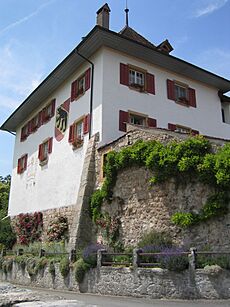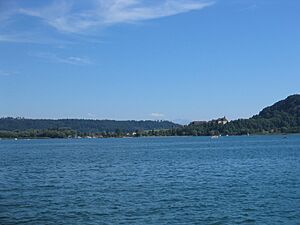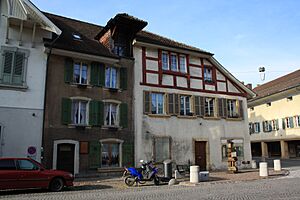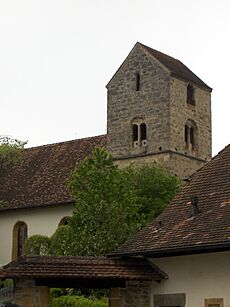Erlach, Switzerland facts for kids
Quick facts for kids
Erlach / Cerlier
|
||
|---|---|---|
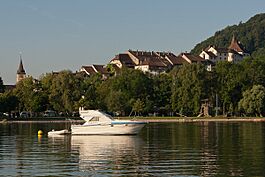
Erlach town and castle above Lake Bienne
|
||
|
||
| Country | Switzerland | |
| Canton | Bern | |
| District | Seeland | |
| Area | ||
| • Total | 3.49 km2 (1.35 sq mi) | |
| Elevation | 433 m (1,421 ft) | |
| Population
(Dec 2020 )
|
||
| • Total | 1,386 | |
| • Density | 397.1/km2 (1,028.6/sq mi) | |
| Postal code |
3235
|
|
| Surrounded by | Gals, Ins, La Neuveville, Tschugg, Twann, Vinelz | |
Erlach (called Cerlier in French) is a town in Switzerland. It is the main town of the Seeland administrative district in the canton of Berne. Erlach is a historic place located right on the beautiful Lake Biel.
Contents
History of Erlach
Ancient Times and Early Settlements
The Jolimont hills are a long range of hills near Erlach. People have lived there for thousands of years. In 1847, archaeologists found three ancient grave mounds. These graves were from the Middle Bronze Age, around 1500 BC. They contained many old items and weapons. More graves from the Hallstatt culture (around 500 BC) were also found. A Roman road used to run along the bottom of these hills.
Founding and Growth of the Town
Erlach was first mentioned in records in 1185. In 1264, Count Rudolf II of Neuchâtel-Nidau gave Erlach special rights. This document, called a Handfeste, helped the town grow. The church in the nearby village of Sunkort was built in the 11th century. Around 1100, the Benedictine Erlach Abbey was started on Saint Peter's Island.
During the 14th century, strong city walls were built around Erlach. The only city gate left today is part of the Rathaus (town hall). Towers were added to the walls in the 15th century. In 1455, the people of Erlach built a hospital. Thanks to the rights given by Count Rudolf II, Erlach had its own mayor and a town council.
Erlach Castle and Its Changes
Parts of Erlach Castle were built in the Middle Ages. The large western tower was added around 1500. In 1848, when Switzerland became a federal state, Erlach Castle became the main office for the district. However, in 1874, it was turned into a school.
Economy and Lake Changes
Erlach became a market town in 1367. This meant it could hold a weekly market and two yearly fairs. Over time, the number of fairs grew to four. The town's economy was varied. People worked in farming, grew grapes in vineyards, fished, and transported goods on Lake Biel. In the 19th century, the watchmaking industry also created many jobs.
Big projects called the Jura water correction happened in 1874–82 and 1962–72. These projects lowered the water level in Lake Biel. This made Erlach's shoreline bigger, adding more land to the town.
Geography of Erlach
Erlach is located on the shores of Lake Biel. It sits about 433 meters (1,421 feet) above sea level. The highest point in Erlach is Jolimont, which is 603 meters (1,978 feet) high.
The town covers an area of about 3.50 square kilometers (1.35 square miles). A large part of this land, about 43.9%, is used for farming. Forests cover about 27.6% of the area. Buildings and roads make up about 15.1% of the land.
Erlach includes the historic Erlach Castle and the old city center. It also has a market area and a newer part along the lake. The village of Sunkort is part of Erlach. There is also a small separate area called Wald on Jolimont mountain.
Erlach used to be the capital of the Erlach district. But on January 1, 2010, it joined the new Seeland administrative district.
Coat of Arms
The coat of arms for Erlach shows a red shield with a golden alder tree. The tree has green leaves. Next to the tree are a golden crescent moon and a golden star.
Population and People
Erlach has a population of about 1,400 people. In 2010, about 12.6% of the people living in Erlach were foreign nationals. Over the past ten years, the population has grown by about 14%. Most of this growth came from people moving into the town.
Most people in Erlach speak German as their first language (about 89.6%). French is the second most common language (3.7%), followed by Albanian (1.9%).
In 2008, about 48% of the population was male and 52% was female. About 20.6% of the population are children and teenagers (0–19 years old). Adults (20–64 years old) make up 61.8%, and seniors (over 64 years old) are 17.6%.
The number of people living in Erlach has changed over time:

Things to See in Erlach
The Jolimont mountain is the highest point in Erlach. It offers amazing views of Lake Biel.
The Sankt-Petersinsel (St. Peter's Island) is actually a peninsula. You can walk or bike to it from Erlach. Although the old Erlach Abbey on the island is not officially part of Erlach, it's easy to visit. Today, it is used as a detention center for adults.
The Ulrich Church in Sunkort is a very old church. It is believed to have been blessed by Saint Ulrich of Zell in the 11th century. The tower where the choir sings was built in the 15th century. The main part of the church was completely rebuilt in the 17th century.
Important Heritage Sites
The Rathaus (Town council house) and Erlach Castle are very important historical buildings in Switzerland. They are listed as national heritage sites. The entire old town of Erlach is also recognized as an important Swiss heritage site.
Economy and Jobs
In 2011, the unemployment rate in Erlach was low, at 1.26%. In 2008, there were 422 people working in the town.
- About 40 people worked in the primary sector, which includes farming.
- 120 people worked in the secondary sector, mainly in manufacturing and construction.
- 262 people worked in the tertiary sector. This includes jobs in sales, hotels, restaurants, healthcare, and education.
Many people who live in Erlach travel to other towns for work. In 2000, about 15.3% of workers used public transportation, and 42.4% used a private car to get to work.
Religion in Erlach
Based on the 2000 census:
- About 14.8% of the people were Roman Catholic.
- About 65.8% belonged to the Swiss Reformed Church (a Protestant church).
- A smaller number of people belonged to other Christian churches, Islam, or Buddhism.
- About 9.7% of the population did not belong to any church.
Education in Erlach
In Erlach, many people have completed higher education. About 37.8% of the population finished high school, and 13.6% went on to college or a specialized school.
The school system in the Canton of Bern starts with one year of optional Kindergarten. Then, students attend six years of Primary school. After that, there are three years of lower Secondary school. Students are grouped based on their abilities. After secondary school, students can continue their education or start an apprenticeship (on-the-job training).
During the 2010–11 school year, 227 students attended schools in Erlach.
- There was one kindergarten class with 21 students.
- There were three primary classes with 63 students.
- There were six lower secondary classes with 120 students.
Erlach has a library called Stedtlibibliothek Erlach. In 2008, it had 5,748 books and other media. It loaned out 16,542 items that year.
Famous People from Erlach
The noble family name von Erlach comes from this town.
- Karl Scheurer (1872–1929) was a Swiss politician. He even served as the President of the Swiss Confederation in 1923.
- Werner Günthör (born 1961) is a famous Swiss athlete. He won a bronze medal in shot put at the 1988 Summer Olympics. He lives in Erlach.
See also
 In Spanish: Erlach para niños
In Spanish: Erlach para niños






